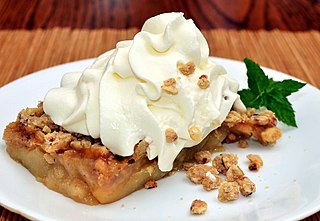
Cream is a dairy product composed of the higher-fat layer skimmed from the top of milk before homogenization. In un-homogenized milk, the fat, which is less dense, eventually rises to the top. In the industrial production of cream, this process is accelerated by using centrifuges called "separators". In many countries, it is sold in several grades depending on the total butterfat content. It can be dried to a powder for shipment to distant markets, and contains high levels of saturated fat.

Thai cuisine is the national cuisine of Thailand.

In cooking, a sauce is a liquid, cream, or semi-solid food, served on or used in preparing other foods. Most sauces are not normally consumed by themselves; they add flavor, texture, and visual appeal to a dish. Sauce is a French word probably from the post-classical Latin salsa, derived from the classical salsus 'salted'. Possibly the oldest recorded European sauce is garum, the fish sauce used by the Ancient Romans, while doubanjiang, the Chinese soy bean paste is mentioned in Rites of Zhou 20.

A salad dressing is a sauce for salads. Used on virtually all leafy salads, dressings may also be used in making salads of beans, noodle or pasta salads and antipasti, and forms of potato salad.

Chilaquiles are a traditional Mexican breakfast dish made with tortillas.
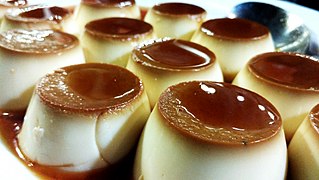
Crème caramel, flan, caramel pudding, condensed milk pudding or caramel custard is a custard dessert with a layer of clear caramel sauce.

Crème fraîche is a dairy product, a soured cream containing 10–45% butterfat, with a pH of approximately 4.5. It is soured with a bacterial culture. European labeling regulations specify the two ingredients must be cream and bacterial culture. It is served over fruit and baked goods, as well as being added to soups and sauces. It is used in a variety of other recipes. Sour cream is a similar foodstuff, except that crème fraîche is less sour and has a higher fat content. Sour cream may contain thickening agents not permitted in crème fraîche in many jurisdictions.

A lardon, also spelled lardoon, is a small strip or cube of fatty bacon, or pork fat, used in a wide variety of cuisines to flavor savory food and salads. In French cuisine, lardons are also used for larding, by threading them with a needle into meats that are to be braised or roasted. Lardons are not normally smoked, and they are made from pork that has been cured with salt.
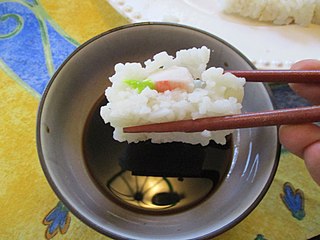
A dip or dip sauce is a common condiment for many types of food. Dips are used to add flavor or texture to a food, such as pita bread, dumplings, crackers, chopped raw vegetables, fruits, seafood, cubed pieces of meat and cheese, potato chips, tortilla chips, falafel, and sometimes even whole sandwiches in the case of jus. Unlike other sauces, instead of applying the sauce to the food, the food is typically placed or dipped into the sauce.

Rajas con crema is the name given to a Mexican dish consisting of sliced poblano pepper with cream. It is very popular in Mexico, particularly in the central and southern parts of the country. It is one of the dishes most commonly served during taquizas, together with tinga, mole, chicharrón, and papas con chorizo. Preparation of the dish involves roasting, peeling and slicing the peppers, sauteing them together with sliced onions, and simmering the mixture with cream. Sometimes chicken broth is added for flavor.

Ají is a spicy sauce that contains ají peppers, oil, tomatoes, cilantro (coriander), garlic, onions, and water. It is served as a condiment to complement main dishes, most oftentimes in Latin American cuisines, and prepared by blending its ingredients using a food processor or blender. Although ají sauce recipes can vary from person to person, there are generally country-specific and region-specific varieties.
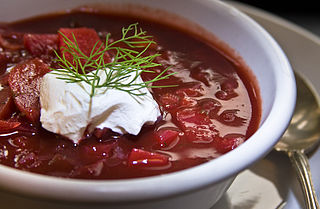
Smetana is the English-language name for the types of sour cream traditionally prevalent in Central, Eastern, and Southeastern Europe, and Central Asia. It is a dairy product produced by souring heavy cream. It is similar to crème fraîche, but nowadays mainly sold with 9% to 42% milkfat content depending on the country. Its cooking properties are different from crème fraîche and the lighter sour creams sold in the US, which contain 12 to 16% butterfat. It is widely used in cooking and baking.
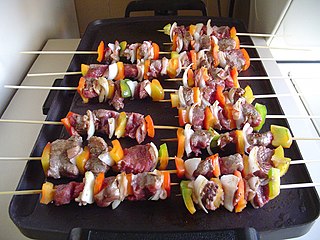
Honduran cuisine is a fusion of Mesoamerican, Spanish, Caribbean and African cuisines. There are also dishes from the Garifuna people. Coconut and coconut milk are featured in both sweet and savory dishes. Regional specialties include sopa de caracol, fried fish, tamales, carne asada and baleadas. Other popular dishes include meat roasted with chismol and carne asada, chicken with rice and corn, and fried fish with pickled onions and jalapeños. In the coastal areas and the Bay Islands, seafood and some meats are prepared in many ways, including with coconut milk. Among the soups the Hondurans enjoy are bean soup, mondongo soup, seafood soups and beef soups. Generally all of these soups are mixed with plantains, yuca, and cabbage, and served with corn tortillas.

Natillas is a term in Spanish for a variety of custards and similar sweet desserts in the Spanish-speaking world. In Spain, this term refers to a custard dish made with milk and eggs, similar to other European creams as crème anglaise. In Colombia, the delicacy does not include eggs, and is called natilla.

Crème brûlée, also known as burnt cream or Trinity cream, and virtually identical to crema catalana, is a dessert consisting of a rich custard base topped with a layer of hardened caramelized sugar. It is normally served slightly chilled; the heat from the caramelizing process tends to warm the top of the custard, while leaving the center cool. The custard base is generally flavored with vanilla in French cuisine, but can have other flavorings. It is sometimes garnished with fruit.

Cream of asparagus soup is a soup prepared with asparagus, stock and milk or cream as primary ingredients.

Watercress soup is a soup prepared using the leaf vegetable watercress as a primary ingredient. It may be prepared as a cream soup or as a broth/stock-based soup using vegetable or chicken stock. Additional ingredients used can include vegetables such as potato, leeks, spinach, celery and turnips, cheese, butter, lemon juice, salt and pepper. Watercress soup can be prepared as a puréed soup by mixing the ingredients in a food processor. It can be served hot or cold, and may be garnished with crème fraîche, shaved Parmesan cheese, drizzled olive oil and watercress leaves.

Avocado soup is a fruit soup prepared using avocados as a primary ingredient. Ingredients used in its preparation in addition to ripe avocados can include milk, cream, half-and-half or buttermilk, soup stock or broth, water, lime juice, lemon juice, salt and pepper. Additional ingredients used can include onions, shallots, garlic, hot sauce, cilantro, red pepper, cayenne pepper and cumin, and water can be used to thin the soup. It is enjoyed widely in areas of Mexico as a classic dish.



















